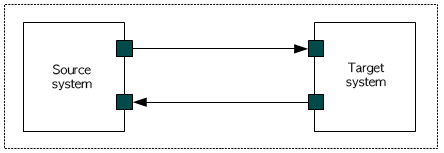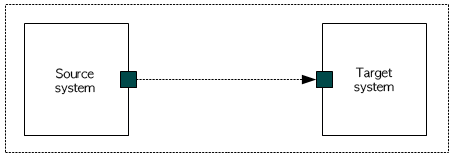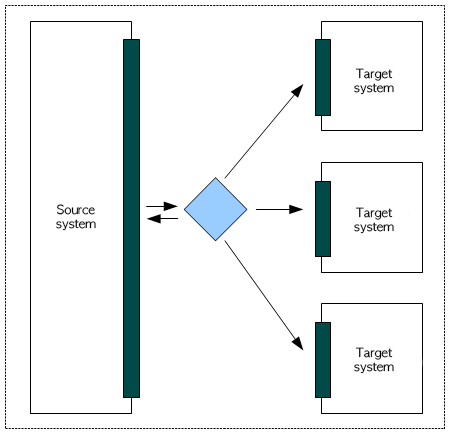

ISM has more than one data processing patterns, but usually the services below are frequently used in general.
Synchronous Request/Response Service send the request and return the process result in synchronous modes.

The service pattern requests the process synchronously in sequential order and receive the result from the multiple target systems. The transferring data to each target system can be the requested data from the source system, or the returned data from the preceding target system. Likewise, the data returning to the target system can be the result data of the preceding target system, or the process result data of a certain system. In addition, the combination of the result data from multiple target systems is also available. In this sentence, "combination" doesn't mean it merge all the data received. It means that it extracts the data from the received and makes the response data.
In the pattern, the number of the target systems determine the number of sequential process requests. If the result from a certain target system erroneous, error processing procedure is executed.
The request is transferred asynchronously between transmitting and receiving system , and the process result is returned asynchronously.

Like the source system requested, the target system returns its result to the source by separated session. In this service pattern, only single per source and target is possible. Also, it requires to distinguish request data from respond data before the operation.
Transfer data from source system to target system in unidirectionally

Source system doesn't receive the request of the result. In this service pattern, the data is transferred from a source system to multiple target systems unidirectionally as the number of target systems in parallel.
The target data changes according to the request of the data from the source system to target system.

Final received response data is determined in synchronous request/response service. The service pattern can be mixed with sync request/response service.
Batch service is to deliver source system to target system. Transferable file has no its limit of size or number. File – File batch service only transfer to one-direction.
This batch service saves generated files of source system to target system's DB as table data. To save file to DB, the data structure of the file must be exist. There's no size limit for transferable file, but the transferable file is only one on batch service operation.
This batch service saves the table data of the source system to target systems in predetermined condition. In this DB-DB data transfer process, the conversion of referred data occurs. There's no limitation of transferable data, but the result of refrred table data must be one. Data inquiry result must be operable by inquiry query no matter how many tables are combined.
This batch service saves the table data of the source system to file of the target systems in predetermined condition. In this DB-File data transfer process, the conversion of referred data occurs. There's no limitation of transferable data, but the result of refrred table data must be one. Data inquiry result must be operable by inquiry query no matter how many tables are combined. Each target system has one generated file.
This deferred service saves the table data of the source system to table data of the target systems in predetermined condition. Deferred service is conducted by ISM cycle using classification key which is the same as serial number. If there are multiple target systems, transfer data to the target system sequentially in a single transaction.
This deferred service saves the table data of the to table data of the target systems in predetermined condition. The target system of this type of service must be one. The service is used to guarantee the order in data transfer condition which requires high processing performance.
This deferred service saves the table data of the source system to file data of the target systems in predetermined condition. Whenever the data is transferred, the file name must be differed.
This deferred service saves the table data of the to table data of the target systems in predetermined condition. The target system of this type of service must be one. The service is used to guarantee the order in data transfer condition which requires high processing performance.